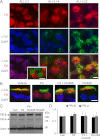Sex hormone-dependent regulation of cilia beat frequency in airway epithelium
- PMID: 22033264
- PMCID: PMC3359952
- DOI: 10.1165/rcmb.2011-0107OC
Sex hormone-dependent regulation of cilia beat frequency in airway epithelium
Abstract
Previous studies have demonstrated a female disadvantage in airway diseases, such as asthma and bronchiectasis. The basis for this sex disparity is unknown. We hypothesized that the female sex hormone, progesterone (P4), inhibits functions of the normal airway mucociliary apparatus. P4 receptor (PR) expression was evaluated in human lung and cultured primary human airway epithelial cells isolated from male and female lung transplant donors. PR expression was restricted to the proximal region of the cilia of airway epithelia, and was similar in men and women. Expression of isoform PR-B was more abundant than PR-A in cells from both sexes. Airway epithelial cell exposure to P4 decreased cilia beat frequency (CBF) by 42.3% (±7.2). Inhibition of CBF was prevented by coadministration of P4 with the active form of estrogen, 17β-estradiol, or the PR antagonist, mifepristone. P4 inhibition was time and dose dependent, with a significant decrease by 8 hours and maximal effect at 24 hours, accompanied by translocation of PR from the cilia to the nucleus. Inhibition of cilia beat was also prevented by treatment of cells with actinomycin D, suggesting that CBF inhibition is a transcriptionally mediated event. Together, these findings indicate that sex hormones influence the function of a key component of the mucociliary apparatus. These mechanisms may contribute to the sex disparity present in airway diseases and provide therapeutic targets for the treatment of these debilitating airway diseases.
Figures




References
-
- The ENFUMOSA Cross-Sectional European Multicentre Study of the Clinical Phenotype of Chronic Severe Asthma. European Network for Understanding Mechanisms of Severe Asthma. Eur Respir J 2003;22:470–477 - PubMed
-
- Celli B, Vestbo J, Jenkins CR, Jones PW, Ferguson GT, Calverley PM, Yates JC, Anderson JA, Willits LR, Wise RA. Sex differences in mortality and clinical expressions of patients with chronic obstructive pulmonary disease: the TORCH experience. Am J Respir Crit Care Med 2011;183:317–322 - PubMed
-
- Morrissey BM, Harper RW. Bronchiectasis: sex and gender considerations. Clin Chest Med 2004;25:361–372 - PubMed
Publication types
MeSH terms
Substances
Grants and funding
LinkOut - more resources
Full Text Sources
Research Materials

